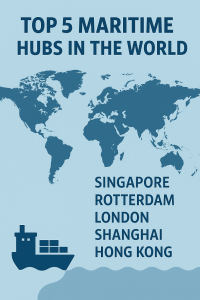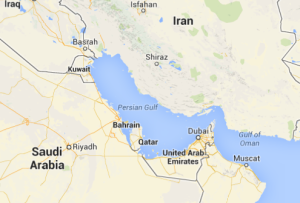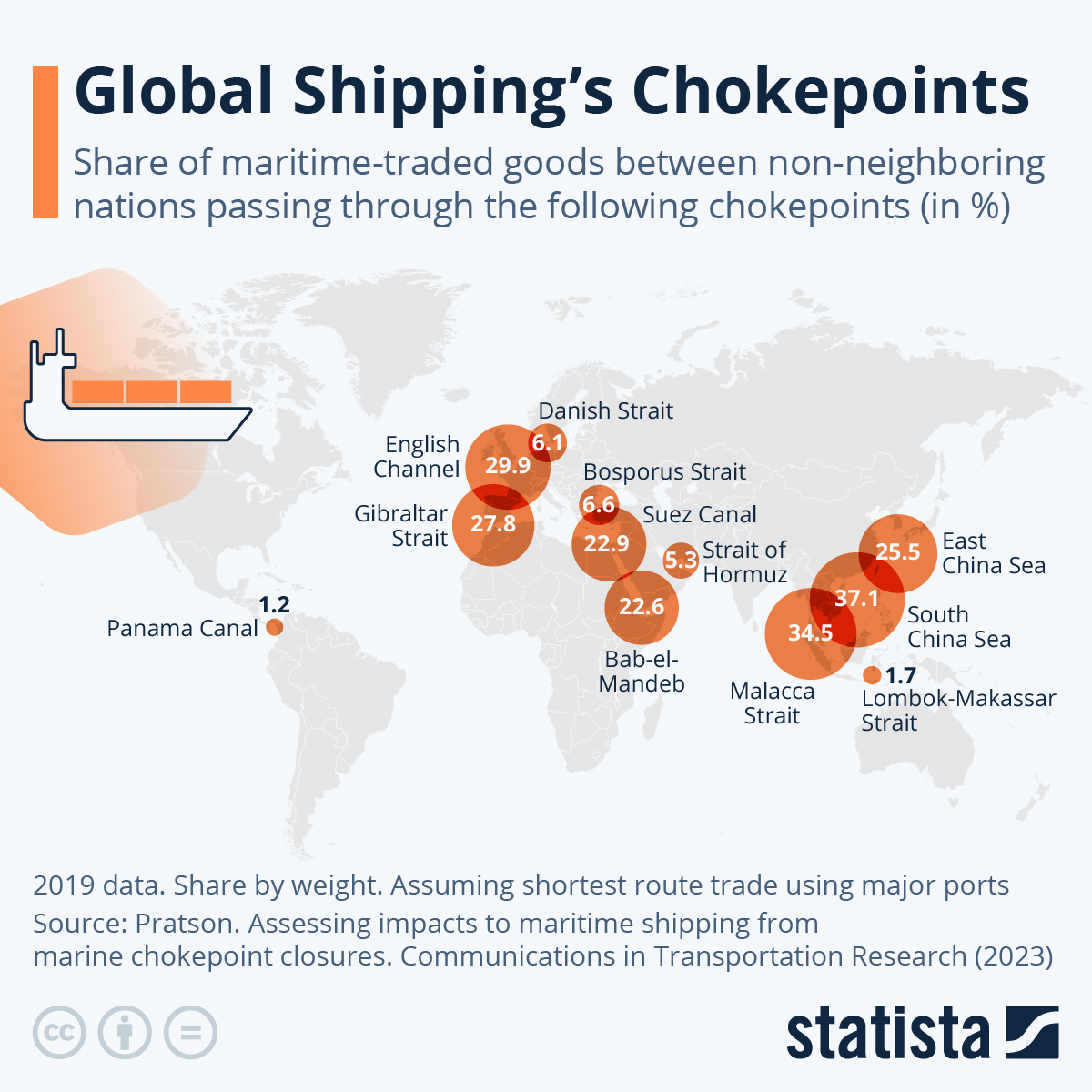Discover the world’s top maritime hubs driving global trade, from Singapore’s digital innovation to Rotterdam’s green corridors. Explore key stats, infrastructure, and future trends shaping these vital ports.
Why Maritime Hubs Matter
 Maritime hubs are the backbone of global commerce, serving as critical nodes in a vast network that keeps economies running. These ports handle an astonishing 80% of the world’s goods by volume, making them indispensable to international trade. Beyond mere docking points, they are sophisticated ecosystems where logistics, cutting-edge technology, and policy intersect to facilitate the smooth movement of goods across continents.
Maritime hubs are the backbone of global commerce, serving as critical nodes in a vast network that keeps economies running. These ports handle an astonishing 80% of the world’s goods by volume, making them indispensable to international trade. Beyond mere docking points, they are sophisticated ecosystems where logistics, cutting-edge technology, and policy intersect to facilitate the smooth movement of goods across continents.
The world’s most advanced maritime hubs are not just about size—they excel in efficiency, sustainability, and innovation. From automated cranes to AI-driven logistics, these ports are setting new standards for the industry. Understanding their operations offers valuable insights into the future of global trade, supply chain resilience, and environmental responsibility.
In this comprehensive guide, we explore the top five maritime hubs that dominate global shipping. We’ll examine their infrastructure, technological advancements, and strategic importance, providing a detailed look at what makes each of them unique. Whether you’re a maritime professional, a logistics student, or simply curious about how global trade functions, this article will give you a deeper appreciation of these engineering and logistical marvels.
1. Port of Singapore – The Digital & Strategic Giant
Why Singapore Leads the Global Maritime Industry
Singapore’s port is more than just the world’s busiest transshipment hub—it’s a pioneer in maritime innovation. Strategically located at the crossroads of major shipping routes, it serves as a vital link between Asia, Europe, and the Americas. In 2023, it handled a staggering 37.2 million twenty-foot equivalent units (TEUs), reinforcing its position as the undisputed leader in container throughput.
Key Strengths of Singapore’s Maritime Hub
-
Digitalization & Automation: The port utilizes an AI-powered Port Optimization System, which reduces vessel wait times by 20%. Automated cranes and smart logistics ensure seamless operations even during peak traffic.
-
Green Maritime Initiatives: Singapore is at the forefront of sustainable shipping, becoming the first port to pilot ammonia-fueled bunkering in 2024. It also invests heavily in liquefied natural gas (LNG) bunkering to reduce carbon emissions.
-
Strategic Geographic Advantage: The Strait of Malacca, one of the world’s busiest shipping lanes, sees 30% of global oil trade pass through it. Singapore’s control over this critical chokepoint gives it immense geopolitical and economic influence.
Future Outlook: What’s Next for Singapore?
Singapore is not resting on its laurels. The government has committed $2 billion to further develop smart port technologies, including autonomous tugboats and AI-driven predictive maintenance systems by 2026. Additionally, the port is expanding its digital trade corridors to enhance connectivity with emerging markets in Africa and South America.
2. Port of Rotterdam – Europe’s Green Energy Gateway
A Leader in Sustainability and Innovation
Rotterdam is not just Europe’s largest port—it’s a global benchmark for sustainable maritime operations. Processing 470 million tons of cargo annually, it serves as the primary gateway for goods entering and leaving the European Union. The Maasvlakte 2 expansion, completed in recent years, added 20% more capacity while integrating cutting-edge environmental protections.
Key Innovations Driving Rotterdam’s Success
-
Hydrogen Hub Development: Rotterdam is partnering with energy giants like Shell to establish a green hydrogen import terminal by 2027, positioning itself as Europe’s clean energy hub.
-
Carbon Capture & Storage (CCS): The Porthos Project, one of the largest CCS initiatives in the world, will store 2.5 million tons of CO₂ annually in depleted North Sea gas fields.
-
Digital Twin Technology: The port employs a real-time digital twin that tracks every ship, container, and truck, optimizing logistics and reducing congestion.
Challenges Ahead: Balancing Growth and Sustainability
Despite its green initiatives, Rotterdam still handles a significant volume of fossil fuels, which account for 35% of its total throughput. The port faces the challenge of decarbonizing without disrupting trade flows, especially as Europe pushes for net-zero emissions by 2050.
3. Port of Shanghai – The Unstoppable Growth Engine
The World’s Busiest Container Port
Shanghai has consistently held the title of the world’s busiest container port, handling a record 47.3 million TEUs in 2023. This phenomenal growth is largely due to the Yangshan Deep-Water Port, a fully automated terminal that operates with minimal human intervention.
Technological Edge: How Shanghai Stays Ahead
-
5G Smart Port Infrastructure: Shanghai uses AI-driven autonomous trucks and cranes, reducing loading times by 40% and improving efficiency.
-
Belt & Road Initiative (BRI): The port is a critical node in China’s BRI, handling 30% of China-EU trade and integrating rail-sea transport networks.
Future Expansion Plans
Shanghai is investing $12 billion in a new terminal, expected to increase capacity by 10 million TEUs by 2030. This expansion will further cement its dominance in global shipping.
4. Port of Dubai (Jebel Ali) – The Persian Gulf’s Trade Powerhouse
Gateway to Emerging Markets
Jebel Ali, operated by DP World, is the largest man-made harbor in the world and serves as a crucial link between Asia, Africa, and Europe. It handles 15 million TEUs annually, catering to a consumer base of 3.5 billion people.
Strategic Advantages
-
Jebel Ali Free Zone (JAFZA): Over 8,500 companies benefit from tax exemptions and streamlined customs procedures.
-
Hyperloop Cargo Transport: Dubai is testing a cargo hyperloop system that could slash land transport costs by 50%.
Challenges: Geopolitics and Trade Disruptions
Recent Red Sea shipping disruptions have forced reroutes, increasing costs and delays. The port must navigate these geopolitical risks while maintaining its growth trajectory.

5. Port of Los Angeles – America’s Pacific Powerhouse
Top U.S. Port by Volume
The Port of Los Angeles handled 9.9 million TEUs in 2023, making it the busiest port in the Western Hemisphere. Despite supply chain bottlenecks, it remains a vital entry point for goods entering the U.S.
Green & Tech Initiatives
-
Zero-Emission Goals: The port aims to convert all terminal equipment to electric power by 2030.
-
Just-in-Time Arrivals: AI optimizes ship arrivals, reducing idling emissions by 60%.
Trade Shifts: The Rise of Nearshoring
Growing nearshoring to Mexico may divert some cargo from LA to ports like Lázaro Cárdenas, challenging its long-term dominance.
FAQ
1. What makes a port a “maritime hub”?
A maritime hub must have deep-water access, high cargo volume, advanced logistics, and global connectivity. Singapore, for example, connects 600+ ports worldwide.
2. How do green ports reduce emissions?
Rotterdam uses shore power, hydrogen bunkering, and carbon capture to cut its environmental impact.
3. Will automation replace port jobs?
While automation reduces manual labor, it also creates new roles in data analytics and remote operations.
Conclusion: The Future of Maritime Hubs
The world’s top ports are racing toward automation, decarbonization, and resilience. Key trends include:
-
Alternative fuels (ammonia, hydrogen) scaling by 2030
-
AI-driven logistics minimizing delays
-
Geopolitical shifts reshaping trade routes
For maritime professionals, staying updated on these hubs is crucial for strategic planning. The evolution of these ports will shape the future of global trade for decades to come.
References
International Chamber of Shipping. (2023). Annual Review of Maritime Trade. London: ICS Publications.
Lloyd’s List Intelligence. (2024). *Global Port Performance Index 2023-2024*. London: Informa.
Maritime and Port Authority of Singapore. (2024). Singapore Maritime Annual Report 2023. Singapore: MPA.
Port of Rotterdam Authority. (2023). *Sustainability Report 2022-2023*. Rotterdam: PoR.
Shanghai International Port Group. (2024). Annual Operations Report 2023. Shanghai: SIPG.
DP World. (2023). Jebel Ali Port: Annual Trade Review. Dubai: DP World.
Port of Los Angeles. (2024). Cargo Statistics and Environmental Report 2023. Los Angeles: POLA.
United Nations Conference on Trade and Development. (2023). Review of Maritime Transport 2023. Geneva: UNCTAD.
International Maritime Organization. (2023). Fourth IMO Greenhouse Gas Study. London: IMO.

